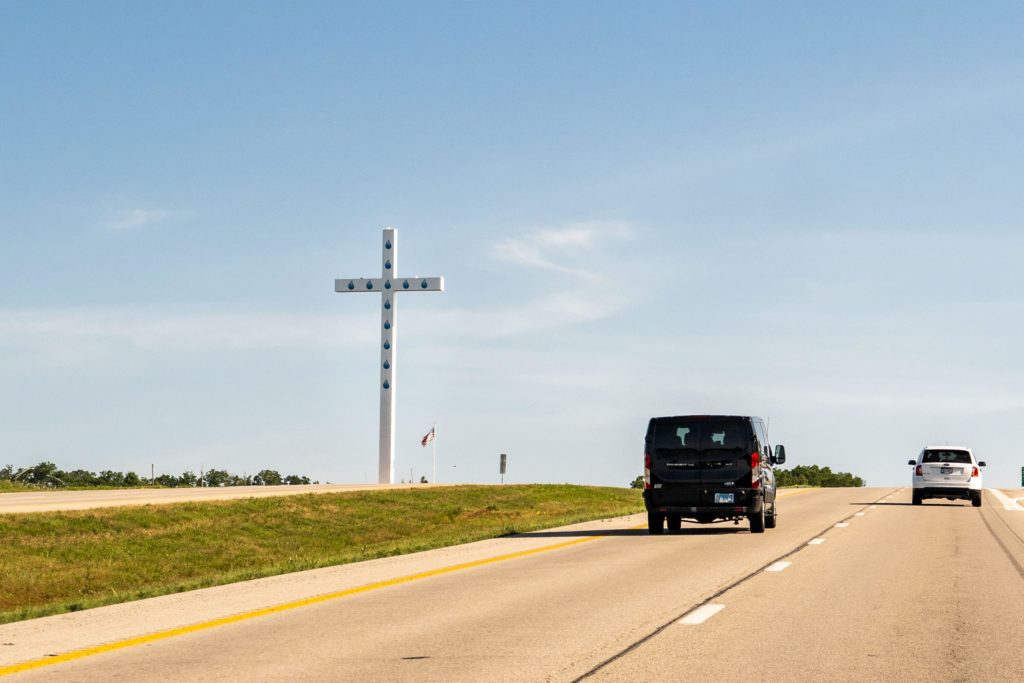They’ll Know We are Christian by the Size of our Cross?
Last week my family took a two-night camping trip with one night in central Missouri and the second on the Arkansas/Missouri border. On the drive, we passed two different churches where the defining feature as one drove past at 60-ish miles per hour was a set of three gargantuan crosses.
I immediately felt agitated.

Walnut Shade, MO: The Branson Cross along side Route 65, built by a nonprofit called Images at the Cross, stands 218 feet tall.
No, my feeling was not because I am one of those Corinthians to whom Paul wrote who were embarrassed or ashamed of the cross. I have long pondered the great value of Luther’s contrast between a theology of the cross versus a theology of glory. To consider a theology of the cross, think what the suffering Christ reveals about humanity and God rather than a theology in which there is nothing but victory, wealth, and success, often defined in secular terms.
My friend and colleague Dr. Joe Bessler introduced me to the work of North American theologian Douglas John Hall who writes passionately about the wealthy North American context’s persistent theology of glory and the negative consequences of that theology on community, on others, and on the planet.
The cross is a proper scandal for anyone who tries to follow the way of Jesus. But gargantuan crosses, visible for miles, are ostentatious public displays. But a display of what?
I perused the website of one of the churches (I could not locate the second, but in looking about, I did find the tallest cross in North America, over 200 feet, is near Branson, MO). On the church website, I did not see stated reasons for why the giant crosses and why three rather than one. Yes, I know the Gospel stories of Jesus being crucified between two other alleged insurrectionists and their near-death dispute/debate about the value of Jesus. But why does the church identify with the three crosses rather than one? Surely not simply because the cluster of three better catches the attention of passing vehicles.
Can you imagine the public reactions in Red counties in America where one might see a 200 foot high Star of David, Crescent and Star, or meditating Buddha?
Why. So. Big?
It is interesting how a religious symbol within a house of worship means something different when displayed publicly. Symbols require context. A cross in a worship space can (actually, should) be a focal point for the congregation.
But take the cross outside, blow it up be a factor of 200, what does it then mean? What does it mean to people with no religion or from a religion that, historically and even today, suffers because of how Christians have treated them? Are the crosses received as invitation, as witness, as proclamation, as an attention-getter similar to blow-up clowns flapping in the breeze at a used car dealer, with eye rolls, as a punch in the nose?
One of my favorite song lines, learned in youth fellowship days, is: “And they’ll know we are Christians by our love, by our love. Yes they’ll know we are Christians by our love.”
By our love. Not by the size of a publicly-displayed cross.
There is no logical contradiction between a church with enormous crosses and striving to be known by the way the congregation loves God, each other, and their neighbors.
But love understood in a theology of the cross, of whatever size, is much more difficult than love interpreted through a theology of glory. It is hard to believe big crosses in public space represent a theology of the cross.
Dr. Gary Peluso-Verdend is president emeritus at Phillips Theological Seminary and is the executive director of the seminary’s Center for Religion in Public Life. The opinions expressed in this blog are those of the author. Learn more about the Center’s work here and about Gary here.


Comments are closed.